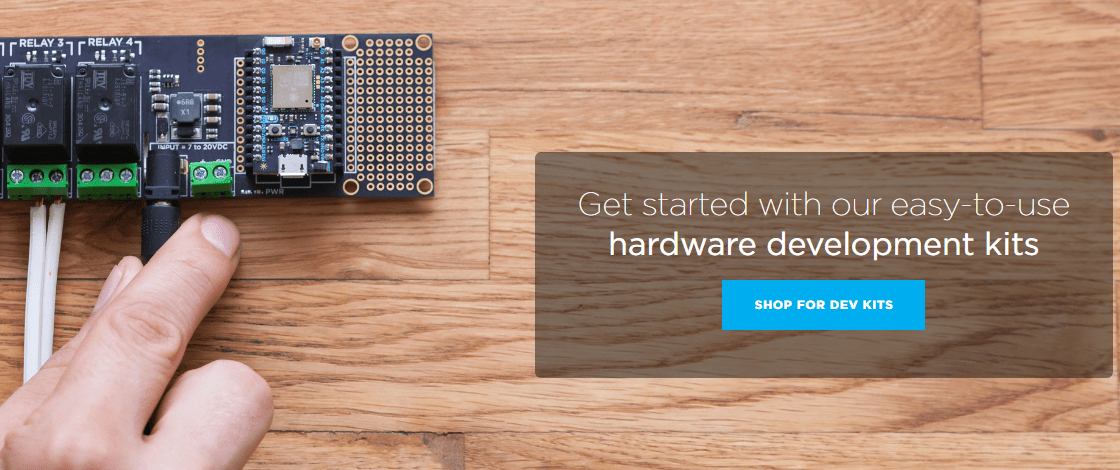Particle CEO: Wanna Win the Big, Shattered IoT Market? Win the Marshmallow Challenge First
Translated by Andrew
Zach Supalla is the co-founder and CEO of the IoT platform startup, Particle, which is rated one of “The Ten Biggest IoT Startups in 2015” by Fast Company Magazine.
With “The New DNA of the IoT Ecosystem” as topic, Zach shared his experience with us. “You’re gonna hear the word Spark throughout the talk,” said Zach in his opening. “Particle set off as Spark. It began from its first IoT product, Spark Socket, and has been running for 4 years. Along the way, we’ve encompassed consumer products, toolkits, and platforms, expecting more possibilities of IoT.”
Starting From a Smart Light Bulb Socket
Zach’s first idea was inspired by his hearing-impaired father. “My dad can’t hear. When I was little, if there were people visiting or phone ringing, the lights blinked. But now we’re all using smartphones. That system won’t work now because he can’t feel the vibration if the phone is not with him. To people without physical difficulties, lights are simply things we turn on when it’s dark, and turn off when not needed. But lights mean more to the hearing-impaired. This is the way they receive information. So I came up with the idea of the lighting IoT.”
“We worked on smart light bulb sockets. Attach Spark Sockets to light bulbs of any specification and connect them through Wi-Fi, then users can control the lights at home via our website and app.”

“My first step was doing it myself with LEDs following the instructing videos online. The initial version of Spark Socket was a mess. Thankfully an investor sponsored Spark Socket so it got more developed and modified, and I also had designers taking care of the appearance. After all the work, the sockets became compatible with light bulbs, and accessible to cloud. The final product posted on Kickstarter turned out attractive as well.”
“Aside from reminding user of phone calls, users can turn the lights on before entering a dark room and remotely turn off the lights in another room; the brightness can be adjusted according to the nature light outside to save energy; you can even set them lighting up gradually like sunrise in the morning.”
“Our first time going for a crowdfunding platform was November, 2012, setting a goal of 250,000 USD within a month. Some of you may think it was a high price, but so was the cost, which has always been a problem in hardware funding. After a month, Spark Socket got 120,000 USD. We failed with still much to go.”
“Though it didn’t go well, it was still a nice try. I can’t help thinking if we succeeded with a goal of 100,000 USD, we wouldn’t have learned that much.”
Failure Brings Attention and Feedback—Restart after 7 Months
Zach said the greatest feedback was media’s attentions. “Large media like TechCrunch, WIRED, and Forbes reported on what Spark Socket did. Although we didn’t make it, more people began to know Spark. Additionally, we could get the big picture of the market from the feedbacks of our sponsors on Kickstarter.”
“After that we went to Shenzhen in China and joined the first hardware accelerator in the world, Haxlr8r, to seek new direction. We bought a light bulb that can change colors remotely, and connected it to the Internet through Wi-Fi, planted chips, and made it a microcontroller. It was like the brain of luminaire. All it needed was a good look, and by attaching it to a light bulb, it became a new product.”
“Then I found Spark was becoming a luminaire company, which wasn’t what we wanted. Since it’s difficult and expensive to make existing hardwares accessible to Wi-Fi, it became Spark’s strength. We can even make devices compatible with different sizes of hardwares. So we transformed to developing small IoT toolkits, which is Spark’s second product—Spark Core.”

“Spark Core is an Arduino Wi-Fi board installed with 72 MHz ARM Cortex M3 processor, CC33000 Wi-Fi module of Texas Instruments, and wireless program editor, enabling developers and makers to realize their ideas and put them on the Internet.”
“During the process, we benefit much from the open source community, so we hope to return as an open platform. The blueprint, prototype design, and materials are all public and available through multiple channels. We insist to keep standard protocols like HTTP, TCP, TLS, SSL, so that development and optimization are easier.”
They promoted Spark Core on Kickstarter in February, 2013, 7 months after their first failure. This time they set the goal up to 100,000 USD, and they made it within an hour, ended up receiving funds of 560,000 USD.
Marshmallow Challenge: The Value of Trial-and-Error
“Teams have to build the tallest structure within 18 minutes out of sticks of spaghetti, tape, string, and a marshmallow on top. Most people evaluate the tools they have, plan and even sketch out. They spend the majority of the time assembling, and put the marshmallow on top in the last 30 seconds. The structures often collapse because the marshmallow is heavier than they think. The sticks can’t hold the marshmallow.”
“In this challenge, among the worst were graduates of business school and CEOs; kids outperformed them. The former spent most of the time building and put the marshmallow on top in the end. The kids, however, kept the marshmallow on top from the beginning, and built upon the previous structure, so they had multiple times to try and fix.”
“Many successful entrepreneurs stressed the idea. The owners of Dyson, Yahoo! and Facebook have said trial-and-error is essential. You adjust instantly along with testing. This resembles the startup cycles and periods. We fix upon user feedbacks.”
“The concept of open source and platform started from the first version of Spark Socket. They released their APIs so the developers could build more luminaire-interactive apps. Particle now provides IoT platforms, hardware modules, and cloud-user device linking, and sales to more than 100 countries. It’s the first leap into IoT for individuals and companies.”
“We grow along with customers. The funding platforms allow us to evaluate the feasibility of our idea. Marc Andreessen, a known VC in Silicon Valley, once said, ‘Software is eating the world.’ What he said implies that software plays an important role in every industry. As the computational cost lowers and implementation varies, different kinds of startups tend to develop their own business potentials, which enable more resources to be utilized on hardware transformation and startups.”
“However, it is worth noticing that single manufacturing industry has a small range of customers, but after entering IoT and cloud, they scale up and generate fragmentary new concepts, which you should learn. Put your marshmallow on top first, then err and fix.”
中文版連結
Particle works on app and smart











留言討論